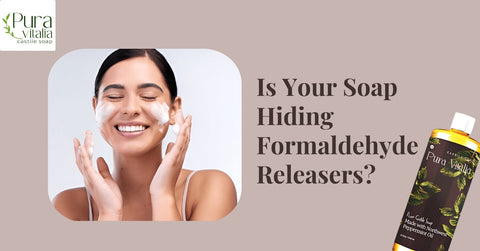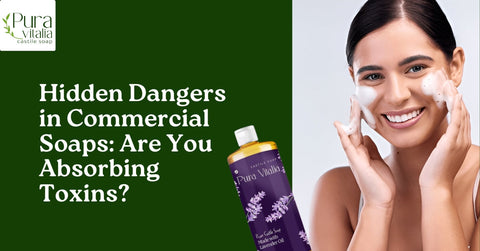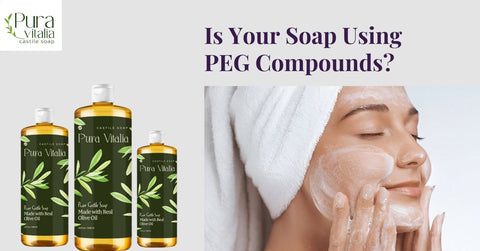You trust your soap to cleanse your skin, dishes, and home. But what if your soap is subtly exposing you to formaldehyde, a skin irritant associated with allergies and long-term health concerns? In many mainstream soaps, formaldehyde releasers—chemicals that release small amounts of this baneful gas over time—are used. These ingredients may dry out your skin, causing rashes or aggravating other skin maladies, such as eczema. Pura Vitalia's toxin-free range of soaps is free from such harmful additives and based on plant sources, assuring your skin, pets, and home are safe and clean.
What Is Formaldehyde in Soap?
Formaldehyde is a preservative used to stop bacteria growth in skincare and cleaning products. Instead of listing it directly, brands use formaldehyde releasers like DMDM hydantoin, quaternium-15, or imidazolidinyl urea. These chemicals break down slowly, releasing traces of formaldehyde. While this keeps soap shelf-stable, it risks skin irritation and allergies.
Formaldehyde is a colorless gas with a strong odor, often used in industrial settings for embalming or manufacturing resins. When used in soap, it prevents mold and bacteria from growing in moist environments like bathrooms. However, the slow release of formaldehyde means your skin is exposed to low doses over time, which can accumulate and trigger reactions.
Why Do Brands Use Formaldehyde in Bar Soap?
Formaldehyde releasers are inexpensive, effective preservatives. They prevent mold in products stored in humid bathrooms, yet they are considered a skin irritant by the FDA and formaldehyde might exacerbate sensitive skin conditions like eczema.
Manufacturers prioritize cost and shelf life over safety. Formaldehyde in bar soap is common because it’s inexpensive and works well in humid conditions. Unfortunately, many consumers don’t realize these preservatives are linked to chronic skin issues. For example, quaternium-15 is found in baby shampoos and lotions, despite its risks.
5 Harmful Chemicals Hiding in Your Soap
1. Formaldehyde Releasers
Many chemicals, such as DMDM hydantoin and bronopol, commonly found in both liquid soaps and bar soaps, release formaldehyde over time. Studies link these with skin allergies and immune sensitivity. With time, that repeated exposure may weaken the skin barrier and make it vulnerable to infections.
How to Avoid Them: Look for labels that say “formaldehyde-free” or “preservative-free.” Pura Vitalia’s castile soap uses natural oils like olive and coconut to stay fresh without synthetic additives.
2. Parabens
Parabens are a synthetic preservative that mimic hormones. They are like formaldehyde in soap in that they will extend the shelf life of the product but could disrupt the natural balance of your body. Common parabens used in soaps and other cosmetic products are methylparaben and propylparaben.
The Risk: Parabens can penetrate the skin and mimic estrogen, potentially leading to hormonal imbalances. Research links them to breast cancer and reproductive issues, though more studies are needed.
3. Sulfates (SLS/SLES)
Harsh detergents like sodium lauryl sulfate strip natural oils from skin and hair, leading to dryness and irritation. Sulfates create the foamy lather many associate with “clean,” but they can damage sensitive skin and scalp.
Who’s at Risk: People with eczema, psoriasis, or dry skin should avoid sulfates. Pura Vitalia’s unscented castile soap skips sulfates, making it ideal for eczema-prone skin.
4. Synthetic Fragrances
These can hide thousands of unlisted chemicals, including phthalates linked to hormone imbalances. Fragrances are a leading cause of contact dermatitis, and their long-term effects on the body are poorly understood.
The Hidden Danger: A single “fragrance” ingredient can contain dozens of chemicals, none of which are required to be disclosed on labels. Opt for fragrance-free options like Pura Vitalia’s castile soap.
5. Triclosan
This antibacterial agent is banned in hand soaps but might linger in older dish cleaners. It’s tied to antibiotic resistance and hormone disruption. Triclosan is still found in some “antibacterial” household products.
Environmental Impact: Triclosan doesn’t break down easily, polluting waterways and harming aquatic life. Always check labels for triclosan or its derivatives.
How to Spot Formaldehyde in Soap
Check the Ingredients
Look for these formaldehyde releasers on labels:
-
DMDM hydantoin
-
Quaternium-15
-
Imidazolidinyl urea
-
Bronopol
If these are listed, your soap likely emits formaldehyde. Brands often mask these ingredients under technical names, so learning these terms is crucial.
Why Trust “Natural” Labels?
Terms like “natural” or “organic” aren’t regulated for soap. Always verify the ingredient list. For instance, some “natural” brands still use imidazolidinyl urea to extend shelf life.
Why Switch to Toxin-Free Soap?
Pura Vitalia’s castile soap uses olive oil, coconut oil, and water—no chemical preservatives in soap. Our unscented castile soap is gentle for eczema-prone skin, pets, and washing veggies.
Benefits of Castile Soap:
-
Multipurpose: Use it for dishes, laundry, pets, and personal care.
-
Biodegradable: Safe for septic systems and the environment.
-
Gentle: Free of sulfates, parabens, and synthetic fragrances.
FAQs About Formaldehyde in Soap
1. Does Formaldehyde in Soap Cause Harm?
Yes. Formaldehyde is a skin irritant and allergen. Long-term exposure may lead to rashes, itching, and shedding skin. The IARC classifies formaldehyde as carcinogenic by inhalation, whereas the risk of carcinogenicity by topical application remains under deliberation. Therefore, to be on the safer side, one should refrain from buying products with formaldehyde releasers.
2. What Are Formaldehyde Releasers in Soap?
Formaldehyde releasers are preservatives that degrade with time and release small but measurable amounts of formaldehyde. Examples would be DMDM hydantoin and quaternium-15. Because they are inexpensive and effective, these chemicals are utilized even though they may cause skin allergies and immune reactions.
3. Why Is Formaldehyde Used in Soap?
To fight bacteria and fungi that diminish product shelf life. Its irritant factor makes it dangerous at a longer time scale. Many brands opt for formaldehyde releasers to avoid listing formaldehyde directly on their labels.
4. Are Formaldehyde Releasers Harmful?
Yes. They release formaldehyde that can irritate the skin, cause allergies, and induce respiratory problems for sensitive people. Although users may not immediately react upon using products, extended exposure increases risk over time.
5. How Can I Tell If My Soap Contains Formaldehyde Releasers?
Look for the listed chemicals DMDM hydantoin, quaternium-15, imidazolidinyl urea, or bronopol in the ingredients list; their presence indicates that formaldehyde is contained in the soap. Brands like Pura Vitalia avoid these additives entirely.
6. Why Don’t Brands List ‘Formaldehyde’ Directly?
Formaldehyde has a negative reputation, so brands use releasers to hide its presence. This loophole allows them to bypass labeling regulations while still using formaldehyde’s preservative benefits.
7. Are Formaldehyde Releasers Banned?
They’re restricted in the EU but legal in the U.S. The EU limits concentrations to 0.2%, while the U.S. has no specific bans. Always research brands or choose toxin-free soap like Pura Vitalia.
Ditch Hidden Toxins Today
Formaldehyde in soap is just one threat—many cleansers hide chemicals that harm your health. Pura Vitalia’s castile soap range cleans safely, with plant-based ingredients for dishes, pets, skin, and veggies. Our unscented castile soap soothes eczema without chemical preservatives in soap or synthetic fragrances.
Ready for safer cleaning? Try Pura Vitalia’s castile soap now—free from formaldehyde, parabens, and harsh additives.
Pura Vitalia: Clean consciously. Live toxin-free.



